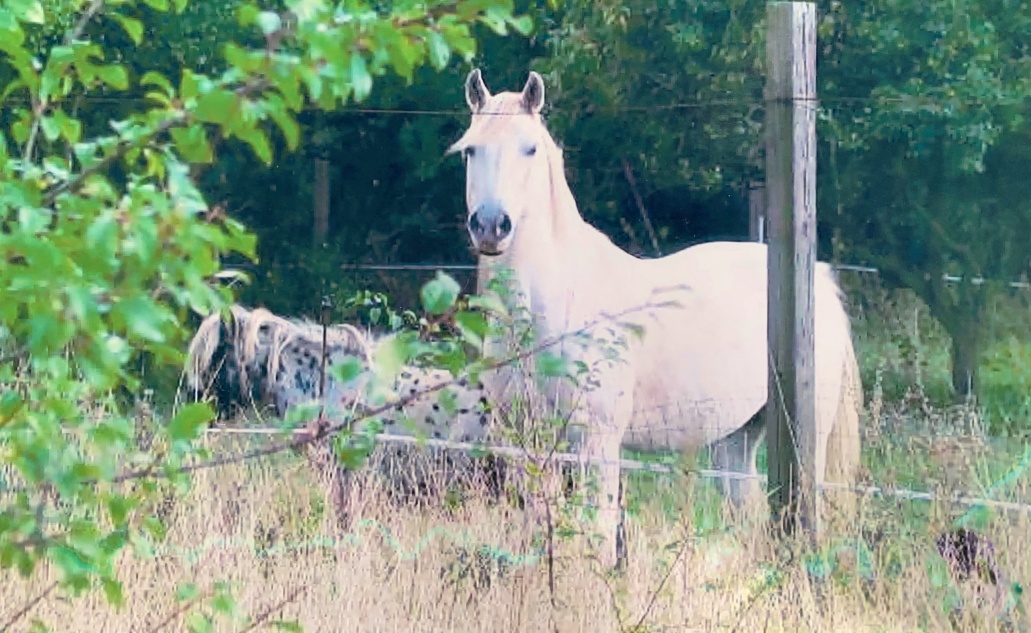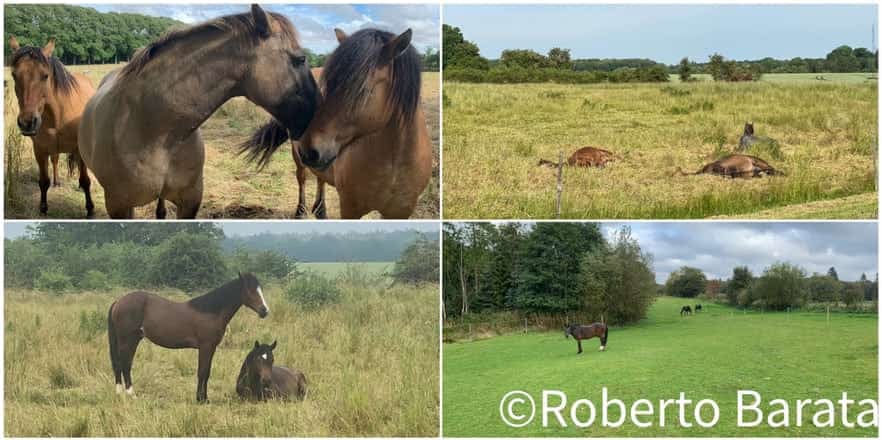
Featured photo: I dedicate this article to Carex Charlie. Photo from Tilde Detz-Jensen.
Date: June 23, 2020
Author: Roberto Barata
Last update: July 2021.
How to cite: Barata, R. (2020). The Silent Suffering of Horses and the (In)human(e) Paradox. Human-Animal Science.
Human beings have lived and worked with horses for more than 5,500 years. Some historians claim that modern civilization would not exist without the help of their hooves—to transport plows, pull carriages, march soldiers into battle, and carry messages of love and war across hundreds of kilometers, which would have been otherwise insurmountable.
However, the reality of this species is not so romantic when we look at its present situation.
The horse has natural characteristics ignored in our human society. Several studies show the proximity between the human and the horse and horses’ interpretations, observations, and adaptations to us. I want to highlight some topics on this subject.
On social adaptation, observation, and interpretation
A study from 2017 showed that horses learn through observing other species, in this case, humans.
A study carried out in 2016 revealed the first evidence of horses’ abilities to interpret positive (happy) and negative (angry) human facial expressions in photographs. The angry faces induced responses indicative of a functional understanding of the stimuli: the horses exhibited a left-eye bias (lateralization usually associated with stimuli perceived as negative) and an increase in heart rate when shown these photographs.
Another study published in May 2019 went further on this subject and showed that horses could even remember the emotional expressions they saw on human faces.
On pain
Horses feel pain, a lot of pain. This pain is hidden by their nature of prey, which makes them demonstrate pain less than humans. But in this comparison, there is an interesting detail. The forensic veterinary pathologist Lydia Tong showed that the horse’s epidermis (the highest layer of skin where the nerves meet that feel the pain) was thinner than the human epidermis. This means that the horse has fewer skin cells between the source of the pain (for example, a whip) and its sensitive nerve endings.
A recent study from 2020 with Dr. Tong’s participation states that: “These findings show that, although horse skin is thicker overall than human skin, the part of the skin that is thicker does not insulate them from the pain that is generated during a whip strike, and that humans and horses have the equivalent basic anatomic structures to detect pain in the skin.”
A study from 2018 showed that the bit causes pain in the horse and, at the same time, results in stereotyped behaviors.
On behavior (human-related) “problems”
Our internal research in Denmark shows that the most reported problems with horses are fear, problems entering horse trailers, and the stereotyped behaviors resulting from the (still) high tendency of humans to confine horses in stalls for several hours or days. The remaining problems result from poor or incorrect teaching based on humans, coercive behaviors, under-stimulation, and lack of habituation to environments. Confining horses to stalls and pens is also a common practice, with anecdotal claims that this practice protects them from hurting themselves in turnout, particularly for valuable performance horses and racehorses.
For two decades, the biggest challenge for etologi.dk in Denmark has been educating humans about the importance of freedom for horses and not confining them in stalls. The nature of horses is not in an urban environment nor stalls, as the studies below show:
A study from 2020 shows the influence of pasture time on the species’ natural behavior.
A study from 2012 states in its conclusion that: “Overall, the notion of letting a horse have access to pasture with voluntary movement rather than stall confinement seems to have merit to help the horse maintain fitness during a period of layoff. In the current study, 24-hour turnout in which the horse travels a significant distance owing to elapsed time and grazing behavior contributed to the ability of the horse to maintain muscle, bone mineral content, and exercise fitness ability.” This confirms our theory, and we are hopeful that there will be a greater awareness of this subject.
A study from 2019 shows that stalling negatively impacts horse bone formation, regardless of age.
A study from 2019 on housing horses in individual boxes states that: “Overall, the main conclusion of this study is that the detrimental effects caused by the spatial, social, and dietary deprivations of this housing system could not be alleviated by small facilities in the box or changes in management practices. To preserve the welfare of horses, it seems necessary to allow free exercise, interactions with conspecifics, and fiber consumption as often as possible, to ensure the satisfaction of the species’ behavioral and physiological needs.”
An experimental study from 2019 on stall architecture’s influence on horses’ behavior showed that: “The results show clear statistical relations between stall architecture and horses’ behaviour, especially STB, their prevalence and type differing according to the type of stall in both studies. Overall, the access to outdoor visibility and its degree (possibility to put the head out or not) had a major effect on the horses’ behaviors, which was the same in both studies, despite the differences between populations in breed, sex, and type of work. The experimental study also reveals that changes in behaviors can be rapid after a housing change.”


Respect for the nature of a species is an essential requirement for understanding all living beings. However, it is worrisome that this subject needs to become a scientific subject rather than already existing as usual common sense—photos by Roberto Barata
Anomalous behaviors in artificial environments may result from the influence of various factors in the sensory field that humans do not consider: lighting, temperature, sound frequencies, electromagnetism, chemical substances, etc.
The welfare topic
Modern techniques in ethology and experimental psychology allow us to have comprehensive knowledge of sensory experience, motor analysis, the effects of hormones, motivation, and species’ behavior when they are in favorable or adverse conditions. This knowledge has created several ways to assess animal welfare and apply it to domestic animals.
Animal welfare is typically measured using health, physiological and behavioral parameters. The evaluation of the natural behavior follows the species’ ethogram (descriptive list of behaviors).
In January 2019, an article was published on a model for assessing pain in horses using a video system.
The overloading of equines is also an issue that seriously compromises their welfare. A new published paper did a review quantifying the impact of mounted load carrying on equines, with a meaningful quote: “There are a number of causes of poor working equine welfare, for example, high workload, improper shelter, food, water, handling (whipping and poor driving), harmful practices (nostril slitting), lack of supporting infrastructure (good farriers, saddlers, and healthcare), marginalisation, harsh environmental conditions, lack of inclusion in legal systems and program enforcement. Overloading equids is one of the many issues that may lead to reduced welfare, a global concern. Brick kiln work appears to be associated with greater welfare problems in working equids compared to other sectors. However, the severity, range, and patterns of welfare and health issues vary between countries and brick kilns within a country. The welfare of working equids should be improved through collective actions of the equid-owning communities along with organizations supporting them.”

The brick kiln is one example of overloading in horses. Photo by visualise.com
A study from 2021 that measures the pressures on some bridles is an exciting finding that I would like to mention: “Removal of the bit from the horse’s mouth means that rein tension forces are distributed to other facial structures. This study demonstrates that these forces are sufficiently high to have detrimental effects possibly. The design and use of bitless bridles should be carefully considered in light of this finding.”
The ethical issues involved
Ever since I began my study and research in the area of anthrozoology (the study of the relations between humans and non-humans) in 2008, I’ve warned of the tendency to promote, through multimedia content and studies, the benefits of non-human animals to humans, even if these studies fail from the start due to a weak hypothesis.
Coincidentally, some of these studies meet the economic market’s needs and social trends, which we can quickly confirm by searching for sponsorships and industry third parties’ funding.
This “wave” of studies boomed ten years ago and started with pets (primarily dogs). In the last five to seven years, horses’ ” benefits ” for therapies and other social activities have increased, with a constant appeal to emotions and a politically correct tendency.
In an area of scientific study, I argue for impartiality and balance, whether the results are positive or not. Future research should not focus on the benefits from A to B (or vice versa) but rather on the short-, medium-, and long-term consequences of these activities for both A and B. My opinion reflects the few studies on the harmful effects of human social and sports activities on non-humans.
Anthropomorphism is present when human behavior and human mental abilities are used as a reference system to explain the character of an individual or a non-human species. This is frequently used with those species which are closer to us.
Although I consider critical anthropomorphism beneficial for a more in-depth study of animal behavior, especially questions one (function) and two (evolution) by the biologist Nikolaas Tinbergen. However, it is imprudent to use “He likes” or “He is happy,” among other arguments appealing to emotions. Most of them are fallacious, and used as justification for the use of horses for the most varied purposes in society, including for our greedy pleasure.
Regarding consequences for non-human species, we should discuss the need to use non-human animals for various social, sporting, and recreational activities and consider their limits. Below, I highlight some articles for you to ponder about.
An article from 2019 about using “jiggers” in horse racing.
In another sporting aspect, this 2016 article warns of unorthodox practices that modify the locomotion and posture of horses for sporting practices, which directly influences several aspects of welfare.
This paper advises caution in using medications such as corticosteroids that place horses at greater risk of injury.
A promising study from 2009 shows the first possible evidence that work may be a source of abnormal repetitive behavior.
Horse carriage in the urban environment
I did a scientific consultation for the animal provider department at Lisbon City Hall about urban horse carriages. The research showed, besides the lack of regulation of these activities and the inexistence of education on first aid, the general health-related issues below:
-
Lameness is due to continuous work on paved streets and inappropriate or unsafe shoes.
-
Cramps and gastrointestinal problems result from lack of exercise, especially during periods of poor seasonal tourism and sudden changes in diet, poor quality food, or changes in the eating schedule.
-
Chronic obstructive pulmonary disease is the most common respiratory problem in many urban environments, and draft horses appear to be more affected than horses or mules outside these environments. Although urban air pollution has been suggested as a contributing factor, there is insufficient data to confirm or deny this claim.
-
Rhabdomyolysis syndrome is a major medical problem for all transport horses. It has a history of several days of vigorous work, such as high periods of seasonal tourism, followed by a few days of rest without reduced feed, followed by the horse being tied up in the first hours of returning to work. However, cases can also occur without this history. Mares appear to be more commonly affected than geldings (Harris 1997). This condition can be fatal without prompt veterinary care.
-
Harness Skin Problems and Wounds: Open wounds in the skin of ill-fitting harnesses are an obvious statement of the operator’s inexperience, inattention, and insensitivity.
-
Heat stroke or heat exhaustion threatens horses working in an urban environment. Infrequent cooling of horses through watering, poor access to electrolytes, obesity, poor conditions, high humidity, disease, and hot pavement conditions are contributing factors. Ground temperatures often far exceed the ambient air temperature.
-
The risk of accidents is a big problem for all horses working in an urban environment. Suppose the horses are spooked and run for some reason. In that case, the escape space will be the urban environment, involving the risk of accidents to people inside and outside the carriage, nearby vehicles, or other objects. However, serious accidents involving carriages are uncommon, undoubtedly due to the selection for this type of transport and the scarcity of public documentation reporting these situations.
Personal notes and recommendations
-
A reflection on the actual need (costs vs. benefits) of using horses for the current tourist activity in the present century.
-
The need to establish clear definitions of equine welfare in different activities and the necessary standards for the promotion of essential care and the general freedoms guaranteed to animals according to the Farm Animal Welfare Council (1993).
-
Seek knowledge within the bibliography and credible references, develop critical thinking about these issues and never be afraid to change your opinion if you consider it necessary, not only for you but also for the horses.
Author’s note
This article is an extended, updated, and revised compilation of two articles originally published in the Portuguese newspaper “Os bichos” in June 2018 and February 2019.
This necessary last update (July 2021) results from many visits and sharing. I had the precious collaboration of Tilde Detz-Jensen, from etologi.dk. Thank you very much, Tilde, for your insight and impressive observational skills for small details. All opinions are my own.
Edited by Dana Lee
References
Baldwin, J.L. and Kurtz, M.B. (1992) Health problems and health regulations of urban carriage horses. In Proceedings of the 38th Annual Convention of the AAEP, pp. 537–546.
Broomé., S., et al. (2019). Dynamics Are Important for the Recognition of Equine Pain in Video. Conference: 2019 IEEE/CVF Conference on Computer Vision and Pattern Recognition (CVPR). DOI: 10.1109/CVPR.2019.01295.
Bukhari, S.S.U.H., et. all. (2021) Quantifying the Impact of Mounted Load Carrying on Equids: A Review. Animals 2021, 11, 1333. https://doi.org/10.3390/ani11051333.
CEN/SHARE (1986) Recommended Guidelines: Urban Horse and Carriage Operations, pp. 4–10. University of Minnesota, Minneapolis, MN.
Cook, W.R. and Kibler, M. (2018) Behavioural assessment of pain in 66 horses, with and without a bit. BEVA. https://doi.org/10.1111/eve.12916.
FAWC (Farm Animal Welfare Council) (1993) Second Report on Priorities for Research and Development in Farm Animal Welfare. Ministry of Agriculture, Fisheries and Food, Tolworth, Surrey, UK.
Graham-Thiers, P.M., Bowen, L.K. (2013). Improved Ability to Maintain Fitness in Horses During Large Pasture Turnout. Journal of Equine Veterinary Science,
Volume 33, Issue 8, Pages 581-585. https://doi.org/10.1016/j.jevs.2012.09.001.
Harris, P. (1997) Equine rhabdomyolysis syndrome. In Current Therapy in Equine Medicine, Robinson, N.E. (ed.), vol. 4, pp. 115–121. W.B. Saunders, Philadelphia, PA.
Hausberger, M., et al. l. (2009). Could Work Be a Source of Behavioural Disorders? A Study in Horses. Plus One. https://doi.org/10.1371/journal.pone.0007625.
Lesimple. C., et al. l. (2019). Stall architecture influences horses’ behavior and the prevalence and type of stereotypies. Elsevier, Applied Animal Behavior Science, Volume 219. https://doi.org/10.1016/j.applanim.2019.104833.
Logan, A.A., et al. l. (2019). Short-term stall housing of horses results in changes of markers of bone metabolism. Comparative Exercise Physiology: 15 (4)- Pages: 283 – 290. https://doi.org/10.3920/CEP190038.
Logan, A.A., Nielsen, B.D. (2021) Training Young Horses: The Science behind the Benefits. Animals. 2021; 11(2):463. https://doi.org/10.3390/ani11020463.
McGreevy, P.D., Boakes, R. (2019). The shocking use of ‘jiggers’ in horse racing. The conversation. Retrieved Jul. 06, 2021 from https://theconversation.com/the-shocking-use-of-jiggers-in-horse-racing.
McLean, A.N., McGreevy, P.D. (2010). Horse-training techniques that may defy the principles of learning theory and compromise welfare. Elsevier, Journal of Veterinary Behavior, Volume 5, Issue 4, Pages 187-195. https://doi.org/10.1016/j.jveb.2010.04.002.
Mercer-Bowyer, S., Kersey, D., Bertone, J. (2017) Use of fecal glucocorticoid and salivary cortisol concentrations as a measure of well-being of New York City carriage horses. Journal of the American Veterinary Medical Association, Vol. 250, No. 3, Pages 316-321. DOI: 10.2460/javma.250.3.316. PMID: 28117637.
Proops, L., Grounds, K., Smith, A., McComb, K. (2018). Animals Remember Previous Facial Expressions that Specific Humans Have Exhibited. Current Biology. https://doi.org/10.1016/j.cub.2018.03.035
Richburg, K. (2007) Bill could halt New York carriage horses. Washington Post, December 17, p. 3. Retrieved Jul. 06, 2021 from https://www.all-creatures.org/articles/hdc-20071217.html
Robinson, N., Bye, T. (2021). Noseband and poll pressures underneath bitted and bitless bridles and the effects on equine locomotion. Journal of Veterinary Behavior, Volume 44, Pages 18-24. https://doi.org/10.1016/j.jveb.2021.05.002.
Ruet, A., et al. l. (2019). Housing Horses in Individual Boxes Is a Challenge with Regard to Welfare. Animals 2019, 9(9), 621; https://doi.org/10.3390/ani9090621.
Ruet, A., Arnould, C., Levray, J., Lemarchand, J., Mach, N., Moisan, M.P., Foury, A., Briant, C., Lansade, L. (2020). Effects of a temporary period on pasture on the welfare state of horses housed in individual boxes. Applied Animal Behaviour Science. https://doi.org/10.1016/j.applanim.2020.105027.
Schuetz, A., et al. l (2017). Social learning across species: horses (Equus caballus) learn from humans by observation. Animal Cognition 2o, 567-573. https://doi.org/10.1007/s10071-016-1060-8.
Smith, A., Proops, L., Grounds, K., Wathan, J., McComb, K. (2016). Functionally relevant responses to human facial expressions of emotion in the domestic horse (Equus caballus. The Royal Society Publishing. https://doi.org/10.1098/rsbl.2015.0907
Tong, L. (2015). Science Answers: Do Whios Hurt Horses?. Horses and People. Retrieved Jul. 06, 2021 from https://horsesandpeople.com.au/science-answers-do-whips-hurt-horses/.
Tong, L., Stewart, M., Johnson, I., Appleyard, R., Wilson, B., James, O., Johnson, C., McGreevy, P. (2020). A Comparative Neuro-Histological Assessment of Gluteal Skin Thickness and Cutaneous Nociceptor Distribution in Horses and Humans. Animals 2020, 10, 2094. https://doi.org/10.3390/ani10112094.

